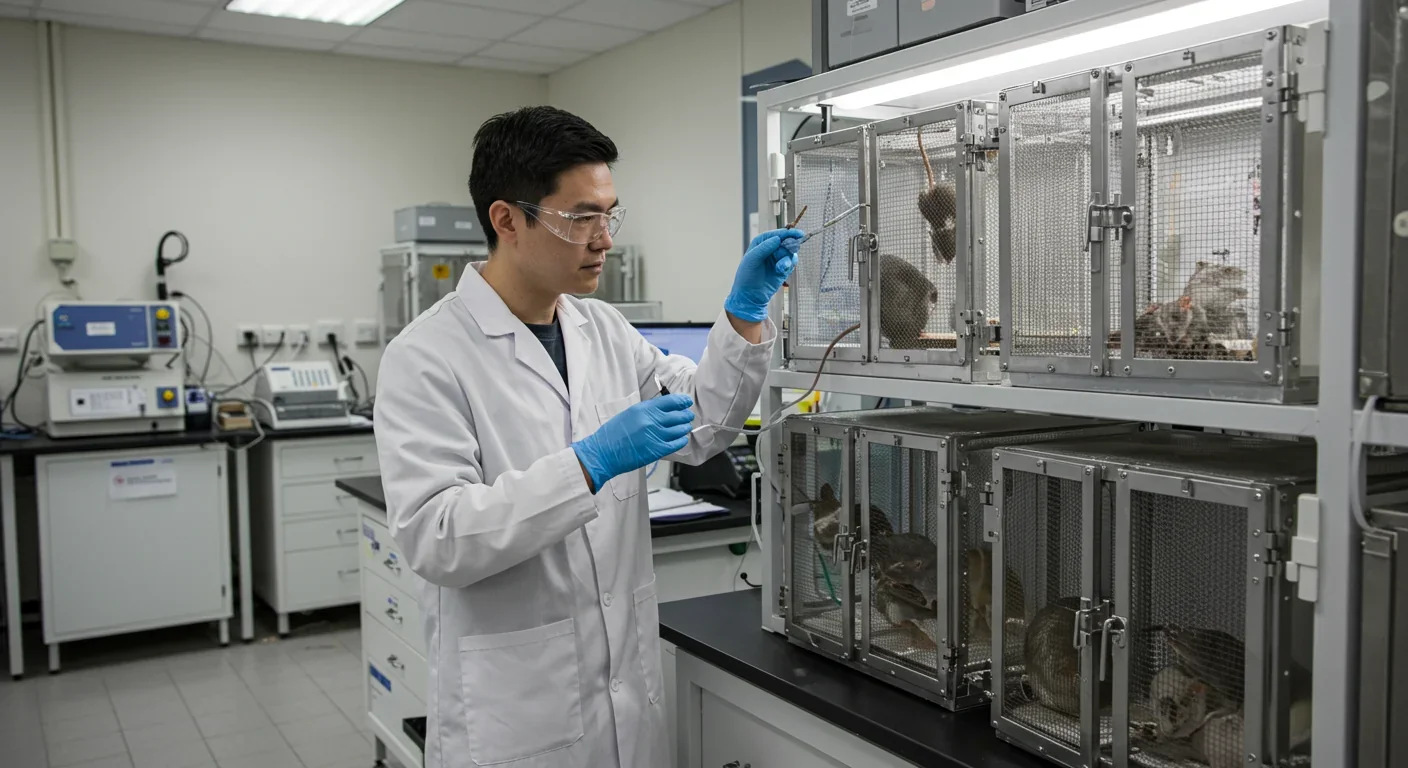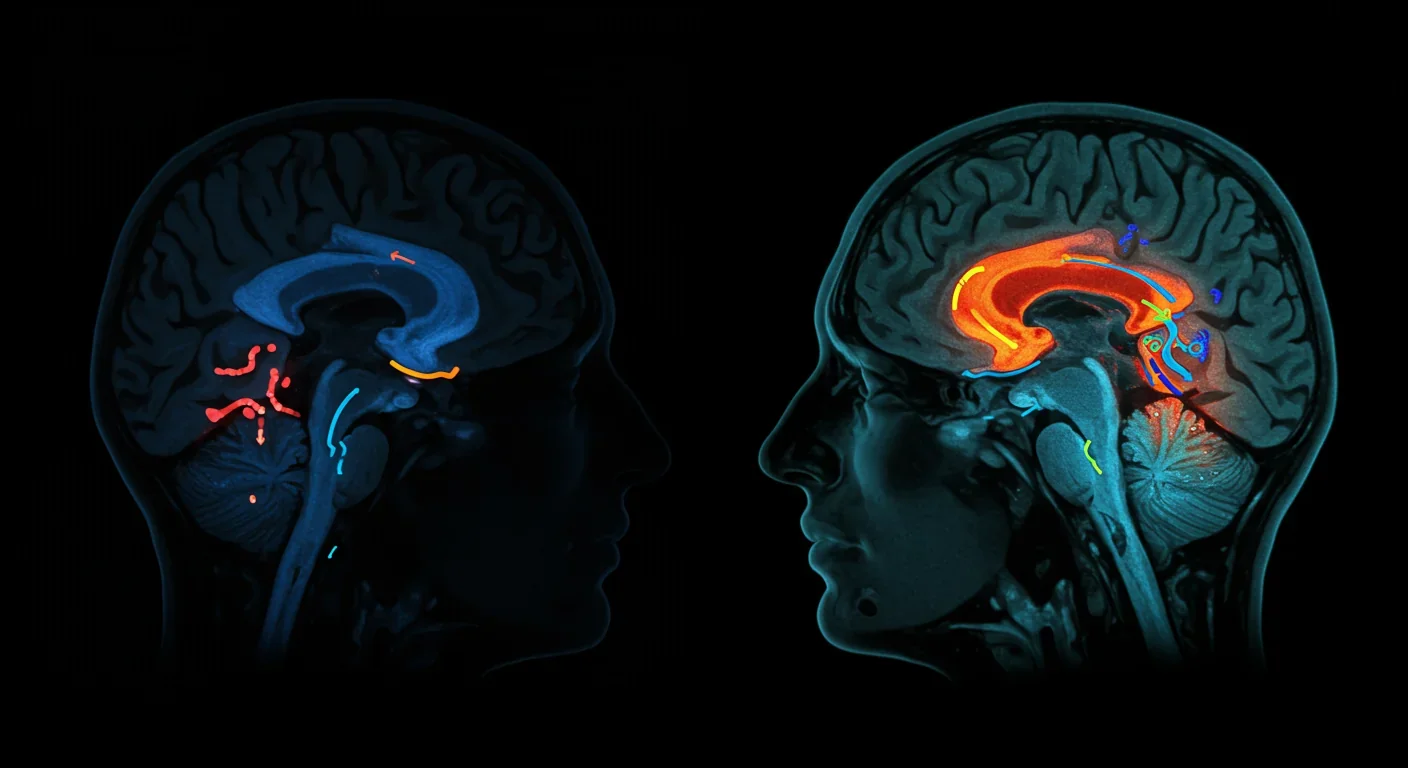The Hidden Memory Trap: Why Your Ideas Aren't Original

TL;DR: The Coolidge effect—renewed sexual interest triggered by novel partners—reveals deep biological drives shaped by evolution. Understanding this neurochemical phenomenon helps couples navigate monogamy's challenges by working with biology, not against it.
In the quiet confines of research labs, scientists have documented something remarkable: a male rat, sexually exhausted after repeated mating with a female, will suddenly spring back to life when introduced to a new partner. This isn't just about stamina—it's about the brain's extraordinary response to novelty. This phenomenon, named after a possibly apocryphal story involving President Calvin Coolidge, has profound implications for understanding human sexuality, relationship dynamics, and why monogamy proves challenging for many species, including our own.

The Coolidge effect represents more than an interesting quirk of animal behavior. It reveals a deep-seated biological mechanism that has shaped reproductive strategies across mammals for millions of years, and continues to influence human sexual desire in ways we're only beginning to understand.
The term "Coolidge effect" supposedly originated from a visit by President Calvin Coolidge and his wife to a government farm. According to the story, Mrs. Coolidge, observing a rooster mating frequently, asked the attendant to mention this to the President. When told about the rooster's vigor, Coolidge allegedly asked, "Same hen every time?" Upon learning it was different hens, he reportedly replied, "Tell that to Mrs. Coolidge."
Whether this exchange actually occurred remains uncertain—historical records don't definitively confirm it. What's certain is that scientists adopted the name in the 1950s to describe a phenomenon they were observing consistently across species. The story, apocryphal or not, perfectly captures the essence of the effect: renewed sexual interest triggered purely by partner novelty.
The Coolidge effect isn't confined to lab rats. Researchers have documented it across an astonishing range of species. Bulls show renewed mounting behavior when introduced to new cows. Rams display similar patterns with ewes. Even pond snails—simultaneous hermaphrodites—demonstrate increased motivation to mate when presented with unfamiliar partners rather than familiar ones.
The Coolidge effect has been documented across mammals, birds, reptiles, and even invertebrates—suggesting a universal biological advantage to seeking novel partners.
The universality suggests strong evolutionary advantages. From a biological perspective, mating with multiple partners increases genetic diversity in offspring and improves reproductive success rates. For males especially, the cost of additional mating attempts is relatively low compared to the potential reproductive payoff. This makes the Coolidge effect a successful strategy that natural selection has reinforced across millennia.
Studies show the effect manifests differently between sexes. Males typically exhibit more pronounced responses to novel partners, though females in many species also show the pattern, just less dramatically. This aligns with evolutionary theories about parental investment—females, who typically invest more resources in offspring, show greater selectivity. Males, facing lower reproductive costs per mating opportunity, benefit more from pursuing multiple partners.

What happens in the brain when a novel partner appears? The answer lies primarily in dopamine, the neurotransmitter associated with reward, motivation, and pleasure-seeking behavior. Dopamine doesn't just make you feel good—it drives you to want, desire, and search. It fuels curiosity and increases goal-directed behavior.
When you encounter something new and potentially rewarding, your brain's dopamine system activates. The nucleus accumbens, a key structure in the brain's reward circuit, lights up with activity. This creates powerful motivation to pursue the novel stimulus. In sexual contexts, this translates to renewed interest and arousal when a new potential partner appears, even if you've just experienced sexual satiation with a familiar partner.
But dopamine doesn't work alone. Prolactin, released after orgasm, plays a crucial counterbalancing role. Prolactin levels rise following sexual activity and remain elevated for some time afterward, contributing to the refractory period during which further sexual activity becomes difficult or uninteresting. The presence of a novel partner appears to override this prolactin-mediated inhibition, allowing dopamine's motivational systems to dominate once again.
"The brain's reward system treats novelty as inherently valuable, releasing dopamine not just for pleasure, but to motivate exploration and pursuit of new experiences."
— From Psychology Today's analysis of dopamine function
Research into opioid reward mechanisms adds another layer. The brain's endogenous opioid system contributes to sexual pleasure and satisfaction. Repeated exposure to the same stimulus—whether food, drugs, or sexual partners—leads to habituation, where the opioid response diminishes. Novelty resets this system, restoring the intensity of pleasure and reward signals.
This neurochemical interplay explains why the effect is so powerful. It's not simply about physical attraction or conscious choice. Deep brain circuits evolved over millions of years are driving behavior in ways that often operate below conscious awareness.
Central to understanding the Coolidge effect is habituation—the decreased response to a repeated stimulus over time. Habituation is generally adaptive. If your brain responded with full intensity to every stimulus every time, you'd be overwhelmed and unable to detect truly important changes in your environment.

But habituation creates challenges in long-term sexual relationships. The same partner who once triggered intense desire gradually becomes familiar. Brain systems designed to detect novelty quiet down. Dopamine responses diminish. The excitement fades not because anything is wrong with the partner, but because the brain treats familiar stimuli differently than novel ones.
Recent research on sexual boredom demonstrates real consequences. A study found that sexual boredom, more than mere lack of desire, predicts lower relationship satisfaction, particularly for women. The findings suggest that routine and predictability in sexual interactions—inevitable byproducts of long-term partnerships—directly undermine satisfaction.
This creates what therapists call the monogamy paradox: the very closeness, security, and familiarity that make relationships stable and nurturing can simultaneously reduce sexual desire. Living together, sharing daily routines, becoming deeply familiar with each other—all the elements of partnership—inadvertently trigger habituation in sexual response systems.
Understanding the biological basis of the Coolidge effect helps explain patterns many couples experience but struggle to understand. The person you love deeply may simply not trigger the same neurochemical cascade they once did. This isn't failure—it's neurobiology.
But recognizing a biological tendency doesn't mean accepting it as destiny. Humans possess cognitive abilities that allow us to understand and work with our biological drives rather than being enslaved by them. The question becomes: how do we maintain sexual vitality in long-term partnerships despite habituation?
Understanding that waning sexual interest reflects neural habituation rather than relationship failure can reduce shame and open honest conversations about maintaining intimacy.
Research points to several evidence-based approaches. One involves deliberately introducing novelty into the relationship. This doesn't necessarily mean new partners—it means new experiences. Trying new activities together, especially ones involving excitement or mild risk, activates similar dopamine pathways as partner novelty. Adventure, travel, learning new skills together—these experiences can transfer arousal to your partner and relationship.
Varying sexual routines matters too. Research on satisfied couples reveals they actively work against sexual boredom by experimenting with different approaches, contexts, and techniques. They prioritize discovery and exploration over efficiency and routine. They maintain curiosity about each other's evolving desires rather than assuming they know everything.

Creating psychological novelty through role-play, fantasy, or different contexts for intimacy leverages the same brain mechanisms the Coolidge effect exploits. You're providing the novelty-detection systems something new to respond to, even within the bounds of monogamy.
The Coolidge effect has implications extending beyond individual couples. It helps explain patterns in infidelity statistics across cultures. While social, moral, and emotional factors certainly influence decisions to pursue outside relationships, the biological pull toward novelty creates a persistent underlying pressure that purely social solutions may not fully address.
Understanding these biological realities might inform more realistic approaches to relationship structures and expectations. Some researchers argue that acknowledging the Coolidge effect could reduce shame and self-blame when partners experience declining sexual interest, reframing it as a biological challenge to work with rather than a personal failing to hide.
Cultural attitudes toward monogamy vary significantly worldwide, and these variations may reflect different ways societies have attempted to reconcile biological drives with social structures. Strictly monogamous cultures face the challenge of the Coolidge effect head-on. Cultures permitting some forms of non-monogamy may be accommodating, rather than fighting, these biological realities. Neither approach is inherently superior—both involve tradeoffs between competing values.
The phenomenon also intersects with modern technology in complex ways. Pornography provides virtually unlimited novelty, potentially triggering dopamine depletion through overstimulation of reward circuits. Some researchers suggest that excessive pornography consumption may intensify the Coolidge effect by training the brain to expect constant novelty, making real partnerships with limited variety even less satisfying by comparison.
While males typically show stronger Coolidge effects, females aren't immune. Research indicates women experience renewed sexual interest with novel partners, though often in more context-dependent ways. Women's sexual motivation appears more influenced by relational and emotional factors working alongside biological drives.
This shouldn't be oversimplified into a "men are visual, women are emotional" narrative. Both sexes possess the same basic neural architecture for reward and novelty-seeking. Differences in expression likely reflect both evolutionary pressures and social conditioning. Disentangling biology from culture remains challenging, since humans develop within richly social environments that shape biology from birth.
"Individual variation in the Coolidge effect is enormous—some people report little change in long-term desire, while others experience dramatic declines. Personality traits like novelty-seeking tendency predict the strength of the effect."
— Research synthesis on sexual behavior patterns

Individual variation matters enormously. Some people report little diminishment in sexual interest toward long-term partners, while others experience dramatic declines. Personality traits like novelty-seeking tendency predict how strongly someone might experience the Coolidge effect. Relationship quality, communication patterns, stress levels, and life circumstances all modulate biological drives.
No single explanation captures all of human sexuality. The Coolidge effect represents one biological current among many shaping sexual behavior. Attachment systems, love, commitment, moral values, practical considerations, fear of consequences—all these factors interact with biological drives to influence actual behavior.
From an evolutionary standpoint, the Coolidge effect solved critical reproductive challenges. For males in species with internal female fertilization, there's no certainty that any particular mating resulted in offspring. Mating with multiple females increases the probability of reproductive success. Natural selection favored males with strong motivation to seek novel partners.
For females, the advantages are less obvious but still present. Mating with multiple males can provide genetic diversity among offspring, hedge against male infertility, and in some species, provide additional resources or protection. Even predominantly monogamous species often show some extra-pair mating, suggesting that pure monogamy wasn't strongly selected for in most mammals.
Humans evolved in small bands where true novelty was limited. You might encounter a few dozen potential partners in a lifetime. Modern environments present thousands or millions of potential partners through media and dating technology. Our Stone Age brains confront modern stimuli they didn't evolve to handle, potentially intensifying effects that were manageable in ancestral environments.
This evolutionary mismatch helps explain why maintaining monogamous satisfaction can feel like swimming upstream. In a real sense, it is—you're working against biological systems calibrated for different circumstances. Recognizing this doesn't excuse infidelity, but it does suggest that sustained monogamous satisfaction requires active work, not just passive good intentions.
The most practical takeaway from Coolidge effect research is that declining sexual interest in long-term relationships isn't inherently pathological. It's a predictable consequence of how mammalian brains process familiar versus novel stimuli. This reframing can reduce shame and defensiveness, opening space for honest conversations about maintaining sexual vitality.
Successful long-term couples often intuitively apply solutions that align with neuroscience. They prioritize shared novel experiences. They resist sliding into routine. They maintain separate interests and identities that keep them somewhat mysterious to each other. They deliberately cultivate curiosity about their partner's inner world rather than assuming familiarity means complete knowledge.
Therapeutic approaches increasingly incorporate this understanding. Instead of treating diminished desire as dysfunction requiring medical intervention, therapists help couples work with their biology by introducing structured novelty, breaking routines, and reestablishing contexts that trigger dopamine-mediated motivation systems.
Some couples explicitly discuss these biological realities and decide that acknowledging them reduces pressure. Others prefer not to intellectualize intimacy. There's no single correct approach—what matters is finding strategies that align with both partners' values while accounting for biological realities.
Biology creates inclinations, not rigid determinism. Understanding our drives gives us the power to work with them intelligently rather than being controlled by them.
The Coolidge effect also highlights why comparisons between relationships are problematic. The passionate intensity of new relationships reflects a neurochemical state that's inherently temporary. Expecting long-term partnerships to maintain that intensity sets an unrealistic standard. Understanding that the brain responds differently to familiar versus novel partners helps establish more realistic expectations about what long-term relationships can provide.
Perhaps the most important lesson from the Coolidge effect is that understanding biological drives gives us more freedom, not less. When you recognize that waning interest reflects predictable neural habituation rather than something wrong with you or your partner, you can respond strategically rather than emotionally.
Biology creates inclinations and tendencies, not rigid determinism. The human capacity for self-awareness, planning, and value-based decision making means we can work with biological realities rather than being controlled by them. We can build relationships that accommodate our need for novelty without abandoning our commitments. We can maintain curiosity and discovery within monogamy. We can choose to invest energy into sustaining passion because we understand why it requires effort.
The Coolidge effect reminds us that our brains evolved to solve ancestral problems, not modern ones. Recognizing this evolutionary inheritance—understanding the deep biological currents shaping behavior—provides tools for navigating contemporary relationship challenges with greater wisdom and less self-judgment.
In the end, the question isn't whether we experience biological drives toward novelty. We do—the science is clear. The question is what we choose to do with that knowledge. Understanding the Coolidge effect offers a chance to work with our biology intelligently, building relationships and lives that honor both our evolutionary inheritance and our capacity to transcend it through conscious choice.

Curiosity rover detects mysterious methane spikes on Mars that vanish within hours, defying atmospheric models. Scientists debate whether the source is hidden microbial life or geological processes, while new research reveals UV-activated dust rapidly destroys the gas.

CMA is a selective cellular cleanup system that targets damaged proteins for degradation. As we age, CMA declines—leading to toxic protein accumulation and neurodegeneration. Scientists are developing therapies to restore CMA function and potentially prevent brain diseases.

Intercropping boosts farm yields by 20-50% by growing multiple crops together, using complementary resource use, nitrogen fixation, and pest suppression to build resilience against climate shocks while reducing costs.

Cryptomnesia—unconsciously reproducing ideas you've encountered before while believing them to be original—affects everyone from songwriters to academics. This article explores the neuroscience behind why our brains fail to flag recycled ideas and provides evidence-based strategies to protect your creative integrity.

Cuttlefish pass the marshmallow test by waiting up to 130 seconds for preferred food, demonstrating time perception and self-control with a radically different brain structure. This challenges assumptions about intelligence requiring vertebrate-type brains and suggests consciousness may be more widespread than previously thought.

Epistemic closure has fractured shared reality: algorithmic echo chambers and motivated reasoning trap us in separate information ecosystems where we can't agree on basic facts. This threatens democracy, public health coordination, and collective action on civilizational challenges. Solutions require platform accountability, media literacy, identity-bridging interventions, and cultural commitment to truth over tribalism.

Transformer architectures with self-attention mechanisms have completely replaced static word vectors like Word2Vec in NLP by generating contextual embeddings that adapt to word meaning based on surrounding context, enabling dramatic performance improvements across all language understanding tasks.